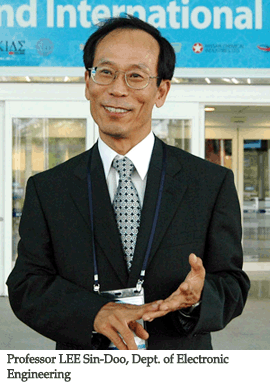 The successful use of any new material in electronic applications depends not only on its electrical characteristics but on how easily it can be formed into the patterns needed for building complex device structures.
The successful use of any new material in electronic applications depends not only on its electrical characteristics but on how easily it can be formed into the patterns needed for building complex device structures.
For organic materials - which hold great promise for making low cost and large area electronics - conventional lithographic patterning techniques are too time-consuming and complex to be cost effective, and involve harsh chemicals that are incompatible with many organics. Furthermore, many alternative processes, such as ink-jet printing, are not yet reliable enough to build complex structures on a large scale.
Professor LEE Sin-Doo at Dept. of Electronic Engineering has developed a new approach to patterning solution-processed organic materials that could solve such problems. Their strategy begins with the growth of a command layer made of a material that undergoes a photo-inscribed 'wetting transition'. This layer is normally hydrophobic, which means that it repels water and similar liquids. But when inscribed by light, it becomes hydrophilic, and attracts water.
By selectively inscribing the command layer with light, the authors made certain parts of their surface hydrophobic and others hydrophillic. When a solution of an organic material was deposited onto the surface, the command layer caused the solution to be attracted only to the hydrophillic areas of the surface. And as the solvent evaporated, it left behind the organic material in the desired pattern.
The key advantages of the technique over other patterning approaches are that is simple, requires no etchants, other harsh chemicals or high temperature processing that can damage certain organic materials, and can produce patterns with micrometre-resolution.
Lee and colleagues demonstrated the potential of their approach for patterning two (2D) and three dimensional (3D) structures. In the 2D regime, they formed arrays of red, green, and blue organic light emitting diodes, side by side, demonstrating the ability to independently pattern multiple sequential layers of different types of materials. And in the 3D regime, they showed that with just one patterning step, and using the hydrophilic interactions of preceding layers to guide the selective wetting of subsequent layers, they could accurately build a stack of red, green, and blue light emitting polymers, one on top of the other.
June 9, 2009
Research Research Highlights
Research Highlights
Research Highlights
Research Highlights

